Football Pick Haikus For Week 12
Football Pick Haikus For Week 12

Thursday, November 24
Green Bay -6.5 At Detroit
It’s Thanksgiving Day!
Can the Lions end The Pack’s
Perfect Season? Yes. PICK: LIONS
At Dallas -7 Miami
The Dolphins won thrice
ruining their chances of a
Franchise QB. Duh. PICK: DOLPHINS
At Baltimore -3 San Francisco
Unless you have the
NFL Network you’ll be
watching Charlie Brown. PICK: LUCY, 49ERS
Friday, November 25
Detroit Red Wings v. Boston Bruins
In Boston instead
of throwing squid on the ice
fans just punch you, guy. PICK: BRUINS
Sunday, November 27
At St. Louis -3 Arizona
The Rams will soon fire
their coach and GM. At least
they have the Cards. PICK: CARDS
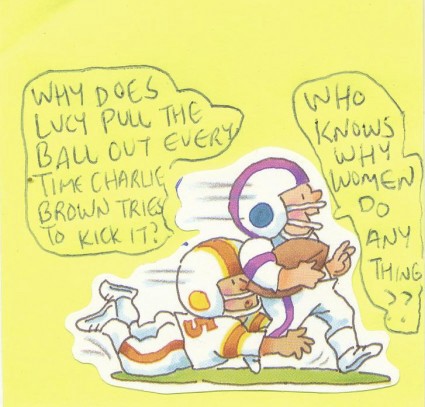
At NY Jets -8 Buffalo
Battle of New York!
Played at home in New Jersey!
Stop Bill-leaving. PICK: BILLS
At Cincinnati -7.5 Cleveland
The Fight for Ohio!
Who wants it badly enough?
The Kentucky Part. PICK: BENGALS
Houston -3 At Jacksonville
Andre Johnson’s back!
Matt Lienart’s starting QB!
Foster’s MVP! PICK: TEXANS!

Carolina -3 At Indianapolis
The great Indy fans
deserve better and that’s just
somewhat sarcastic. PICK: PANTHERS
At Tennessee -3 Tampa Bay
Remember that movie
“Remember the Titans?” Well,
I forget about them. PICK: BUCCANEERS
At Atlanta -9.5 Minnesota
Falcons should win
unless their coach calls a bad
play in Overtime PICK: FALCONS
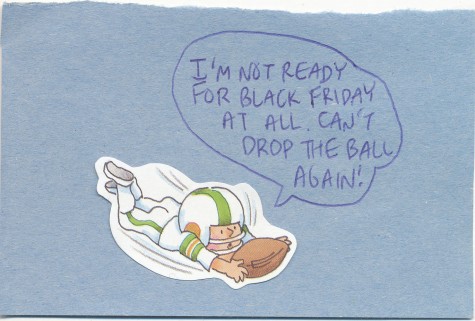
At Oakland -5 Chicago
Why do teams punt to
Devin Hester? Just please go
for it on 4th down. PICK: RAIDERS
At Seattle -4 Washington
Redskins’ approval
ratings come in just under
Supercommittee’s. PICK: SEAHAWKS
New England -3 At Philadelphia
Dream Team plays better
with Vince Young at Quarterback.
Too bad Vick’s starting. PICK: PATRIOTS
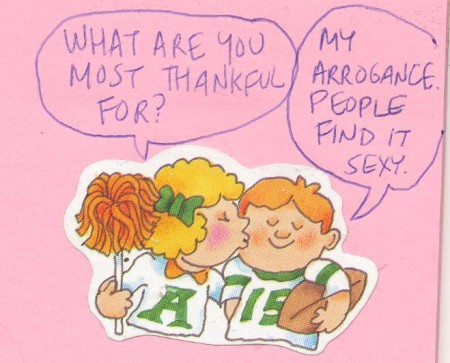
At San Diego -6.5 Denver
Cheering against Tim
Tebow is like praying for
Voldemort to win. PICK: BRONCOS
Pittsburgh -10.5 At Kansas City
10 dead men and 1
healthy Troy Polamalu
can beat this Chiefs’ team. PICK: STEELERS
Monday, November 28
At New Orleans -7 NY Giants
Giants’ annual
late season swoon in effect.
Pass rush is nice, though. PICK: SAINTS
Last week’s Haiku Picks went 5–7–2. Season to date is 72–88–5. Have a
Happy Holiday!
Jim Behrle tweets at @behrle for your possible amusement.
Report: Dog Has Different Name
I’m not sure whether it’s comical or horrifying that we live in a world where a sentence like this is not only comprehensible but unremarkable, but here we are: “A labrador, which became an internet hit, is actually called Fenton and not Benton as previously thought, according to the boy who shot the video of it being chased by its owner.” Yes, there is video.
From Green Corridor To Thick Edge: The Linear Park
by Diana Balmori

This excerpt comes from Diana Balmori’s A Landscape Manifesto. Balmori Associates, her landscape and urban design firm, recently completed a nine-mile linear park on the abandoned New Haven railroad in Connecticut.
Converting a railroad corridor to a linear park results in an essential transformation of a past artifact. Though linear parks and other new landscape forms take their structure from the past, they have risen to the level of new typologies. They mark the beginning of a new landscape agenda. The example of an abandoned railway line made into a linear park or greenway will serve as the poster child of such ecological transformations.
This kind of transformation is not what it may first appear. Some members of the public consider the linear park a “greening” and the return to nature of an industrial mechanized corridor, where coal- or oil-driven engines polluted a strip of land for hundreds of miles. But the reality is more complicated. It is true that the making of the rail line into a greenway often involves planting trees along its edges and removing railroad ballast. But in most cases, the removed ballast is unfortunately replaced by asphalt, making the corridor surface impermeable, and thus ecologically a loss. Whatever vegetation is in place or is added to this trail generally has little in common with the original vegetation; it is not a return to the plant life that was there before the railway. What will grow on this line now will be vegetation which flourishes along edges. There will be many invasive plants which prosper in these situations, and the animal life will also be edge species. The greenway will also contain vegetation changed by having survived decades of application of herbicides (to keep railroad lines clear of vegetation) and by having endured diesel oil and coal emissions. As a corridor for mass transit, it could also be considered to have been a greener artifact than the resulting pedestrian and bike greenway, though its function as a space which permits people to walk and bike does enhance the quality of human life.
It is not a return to the plant life that was there before the railway. What will grow on this line now will be vegetation which flourishes along edges.
Metamorphosis is taking place before our eyes, and we are essaying a new vocabulary for what is emerging. We are taking an old cultural artifact, the product of a heavy steel and iron industry, and reverting to a hybrid system; we are taking rigid industrial systems that overpowered and separated themselves from the living systems surrounding them and allowing life to infiltrate them and transform them.
Linear parks are dynamic rather than static; they are not peaceful retreats but ways. A huge network of outworn and defunct transportation systems and public-utility corridors — canal lines, railroad lines, waterfronts, abandoned ports, utility rights-of-way — is being converted into open public space. That they have become a typology shows their success; they have exceeded and moved on from the artifact that generated them — the railroad corridor — and have spread to anything that can take a linear format.
The large-scale abandonment of railway lines across the United States gave rise to the creation of these linear parks, or greenways. The possibilities of this new form have not yet been fully explored. More appropriate to our times and culture than the traditional central urban parks of the Olmsted era, the linear park differs from them in many ways. Nonetheless, this new park, like those of the nineteenth century, continues to embody our civic ideals; today’s greenway has sparked the first truly widespread citizens’ movement concerning public space since the great park era of the 1830s to 1860s, eliciting the same broad-based grass-roots idealism and support as the nineteenth-century urban parks did. This movement has spawned citizens’ organizations that support various individual conversions of old infrastructures to new parks, as well as national nongovernmental organizations (NGOs) such as Rails-To-Trails; it has also become a strong base for another NGO, the Trust for Public Land, which has been brought in to negotiate land acquisitions from the most challenging of clients, the railroad companies.
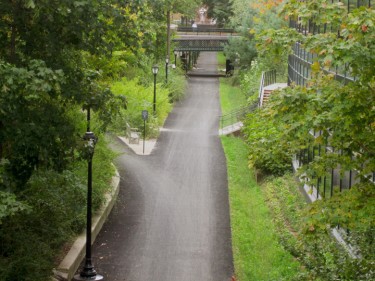
The main characteristic of this new public space, the linear park, is above all the creation of a dynamic set of connections rather than a destination. It responds to a new stage in our thinking about transportation and to the peripatetic spirit that has long characterized American life. The linear park opens pathways to diverse neighborhoods and new recreational spaces and experiences of nature; it invites exploration of alternate modes of transport and of cultural resources. It weaves connections between city and suburb, suburb and country, and nature and culture, and among people of different origins, ages, or sexes. It is an answer to the increasing cultural isolation and physical separation in which we find ourselves.
Linear parks are the twenty-first-century park par excellence. Their implications are dramatic: for a relatively small amount of money, these narrow green corridors can reconnect parts of a city, weaving themselves through it, spreading themselves democratically to reach all areas. They can be attached to streams, rivers, or shores to provide soft edges and restore floodplains. And they function as pathways for people to travel on foot or bicycle, not as ancillaries to an avenue of cars. Though the idea of the linear park is less than twenty-five years old, it has the potential to remobilize our life in cities, encouraging pedestrian movement.
There are many other positive effects of greenways. They can foster a community of businesses along their edges, so that neighbors can once again walk, bike, or skate to the store for a loaf of bread or a bottle of aspirin. They can also provide critical migration corridors for animals through urban areas. They are active landscapes, which can introduce open, green space to various parts of the city; intensify topographic features, rivers, ridges; offer a soft surface capable of absorbing rainwater; and let people escape the car-dominated hardscape.
The transformative power of linear parks comes from the connections they are capable of producing. Up to now, linear parks have developed without arms, as straight 10- to 15-foot-wide strips along the path of an abandoned railway, canal, or utility corridor. But linear parks can also become links (either as permanent paths or as temporary one-day street closures) to museums, to bakeries, to marathons, to concerts, to state parks, to political rallies. This modest caterpillar with the capability of becoming a centipede is a landscape that can actively change a community: greening, invigorating, and connecting.
One of the chief values of the linear park is that it addresses the problem of socioeconomic separation to which the suburb contributes. Greenways, which accommodate movement on foot or bike, might be possible restitchers of the urban fabric, joining urban centers and suburbs to one another recreationally and culturally, providing the continuity of a common space. The linear park enhances the character of all the neighborhoods it connects. It might provide an outdoor activity for people in a medical or child-care facility, or offer space for educational and aesthetic activities for children, teenagers, or the elderly. In other words, an interplay can be achieved between continuity and locality, in response to the specific needs and characteristics of each neighborhood it transverses. In this way, the linear park can offer many different experiences.
For a relatively small amount of money, these narrow green corridors can reconnect parts of a city, weaving themselves through it, spreading themselves democratically to reach all areas.
In a time when open land is being voraciously consumed by suburbs and unending construction, the linear park extends a continuous living and healing linear public tissue. It is a habitat corridor which fosters life rather than expanding and isolating suburbanization, a continuous path through city, suburb, and farmland. Along greenways, the direct human experience of the landscape, which had often been lost in the industrial age, is recaptured. It is not simply a modest tweaking of our concept of the park, but a major reconstitution of the way we use space and time and of how we view transportation. We cannot yet imagine the consequences of this transformation. By converting these corridors into havens for pedestrians and cyclists, we are no longer relegated to the sidewalks along highways, but become the shaping force of the corridor, free from all machines other than those powered by our own energy.
This new park system, with human motion at its heart, promises to be economically productive. The linear park energizes areas around it, just as the railroad and highway before it did. Though it invites dense development along its edges, we have the opportunity to think about how we wish to implement and direct that growth. The linear park can increase land values and attract premium residential areas around its perimeters, just as nineteenth-century parks did. At the same time, however, the continuity and length of these corridors also lend themselves to a variety of commercial and institutional uses. Moreover, there is a political potential in these parks, as new avenues to community empowerment.
The originality of the linear park is to be expressed, not buried in ideals and agendas of the past. I think it is not too idealistic to propose that clean energy sources be used to build greenways; that linear parks should be drained, planted, built, and maintained to restore a healthy environment; that they thus become reliable refuges in which plants, animals, and people can thrive. We can, in these modest strips of land, create a blueprint for the life we wish for ourselves.
One valuable aspect of linear parks is that they stem from local initiatives. It requires a group of motivated citizens who band together, pay for a regular newsletter, and pressure their local government to acquire abandoned corridors of railroads and canals. This is often a slow process. In the case of the Farmington Canal in New Haven, Connecticut, it took more than 15 years, and progressed bit by bit. These projects shepherded by citizens’ groups, moving gradually but persistently, are a lesson about American society’s potential for action.
This new landscape at city scale has already entered the urban fray, putting citizens’ associations, politicians, railroad companies, NGOs, and state DOTs in one jousting arena. The conflicts and their resolution are not to be taken for granted. Though the citizens’ movement has been successful in many instances in obtaining the land from the railroads, there have been many compromises: the land in most cases is simply being banked for new public transportation systems. Also, the majority of these projects receive external funding (one million dollars a mile), which has meant that only their use has been transformed; no aesthetic language has been developed for them as a new modern typology. The work of transformation usually consists in making a narrow band — typically 15 to 20 feet — of asphalt pavement with some markings or signs at road crossings, thus creating paths for bikes and pedestrians. For a landscape’s new typology to succeed, landscape artists need to enter a battlefield of competing interests and experiment with alliances to shift economic interests toward it. 2 These struggles and partnerships are not only with client groups, but also with others who have the various types of professional expertise needed to create a new typology. The economics for linear parks have kept them from developing a landscape aesthetic which reveals the new sustainable relations between humans and nature. They still speak the old language of suburban “nature” trails, echoing an old relationship with nature.
Diana Balmori is the principal of Balmori Associates and author, most recently, of Groundwork (coauthored with Joel Sanders). On December 8th, she’ll be part of a discussion, “Urban by Nature: Healing the Landscape/Architecture Divide in NYC,” at the Museum of the City of New York.
Images courtesy of Balmori Associates. Author photo by Margaret Morton.
A Computer that Brings Joy to the World
by Awl Sponsors

Chances are, you’re already sick of Christmas music. You’ve heard enough “Deck the Halls” and “I Saw Mommy Kissing Santa Claus” to last you until New Year 2013, if not the next decade. You’d prefer to curate your own quality collection of seasonal music — and HP’s new dv6t is the perfect tool to help you do that.
The HP dv6t laptop computer was built with entertainment in mind: It features state-of-the-art Beats Audio™ and Quad-Speakers, which block out the white electronic noise and play your favorite songs with a clarity you’ve never experienced before. Only HP computers have Beats Audio™, so you won’t find this sonic experience anywhere else.
And, if you don’t feel like watching that one Christmas movie staple for the zillionth time while you’re visiting your folks for the holidays, you can also take advantage of the dv6t’s fantastic cinematic features: a 15.6 inch BrightView LED display and a built-in high-definition Blu-ray player. Watch your fave holiday movie in the comfort of your bedroom, and enjoy the crystal-clear visuals, rich sound, and black comedy.
The HP dv6t can handle more than media: With its 2nd generation Intel® Core™ i5 processor, it can provide built-in visuals, four-way multitask processing, and extra performance on demand, whether you need it for work, gaming, or simply watching movies and listening to your favorite tunes.
Learn more about the HP dv6t at hp.com/holidays.
Tired Thing Funny Again
https://www.youtube.com/watch?v=iU7y81FBxu4
If you told me yesterday that it was still possible for someone to do an amusing Downfall meme I would have been all, “Right, I’ve got a comical Xzibit macro to sell you.” And yet, somehow, this works! Also, I guess the Internet is over now. Good job, everyone. [Via]
Paul Motian, 1931-2011
The legendary drummer Paul Motian, whose work in the first Bill Evans Trio alone would have made him a member of the jazz canon, has passed away at the age of 80. There’s some nice stuff here.
Bobby Rush Is 65
Happy 65th birthday to Illinois Rep. Bobby Rush, the only man to ever defeat Barack Obama in an election. So far.
British Mutant Proves Popular With Knifecrime Island's Ladyfolks

There is absolutely nothing I can add to this, so I will just leave it here that we may all marvel at its sheer amazingness.
How to Steal Money from Manhattan, with Columbia's Pro-Biz Think Tank
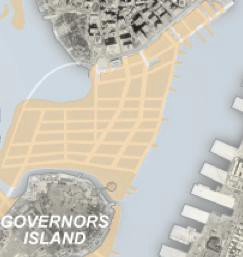
The Center for Urban Real Estate of the Columbia’s Graduate School of Architecture, Planning and Preservation sounds like such a refined academic institution! But apparently it’s pretty much the Heritage Foundation of land use. The direct of the “Center” (funded in part by your developing friends at the Durst Organization!) is a former executive vice president at your friendly local developer the Related Companies, where he still consults. (Just to pick one: guess who’s responsible for the disgusting Gwathmey building on Astor Place? Yes.) And so this oh-so-objective piece in the Times on the Center and, I paraphrase, “wouldn’t it be hilarious if they connected Governors Island to Manhattan with a landfill bridge” and “wouldn’t it be neat if they rezoned to basically do away with the guiding principles of air rights in Manhattan,” is an exceptional launching pad for the Center’s pro-developer “ideas.” All this is cast as how it would make the City money. (Landfilling around Governors Island would “generate $16.7 billion in revenue for the city” over 20 to 30 years is their claim.) This would be the next Westway if it wasn’t pretty much obviously untenable. Points for dreaming big (business) though!
Mock Goose And Other Dishes Of The War-Rations Diet
by Stephany Aulenback
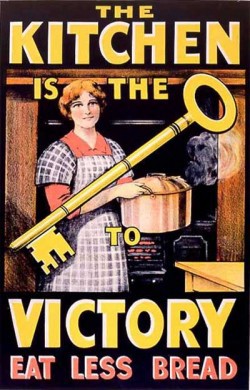
There is a website, called The 1940s Experiment, whose proprietor, Carolyn Ekins, who was born and raised in the UK but now lives in Canada, is attempting to lose a hundred pounds by following a wartime rations diet, specifically made up of the foods eaten by the British public during World War II. For every pound she loses, Carolyn will recreate one authentic wartime recipe and post about it. She has already posted recipes for Mock Goose (made with lentils), Potato and Carrot Pancakes (“delicious”) and an Eggless Fruit Cake (“looks curiously like meat loaf”), among many others. Carolyn has attempted — and succeeded at — this type of diet before; in 2006, she lost 57 pounds following the diet. This time, about six weeks in, she’s lost around 25 pounds.
The term “rationing” does not usually bring to mind images of glowing health, but rather horror stories like the one found in Dangerous Muse, a biography of the writer Lady Caroline Blackwood, who was an heiress to the Guinness fortune and wife to both painter Lucian Freud and poet Robert Lowell (although not at the same time, of course). When she and her two siblings were small during World War II, one of their nannies ate most of the children’s rations herself. Caroline and her sister were saved by school lunches; their younger brother Sheridan, not yet in school, used to have to beg for food from the tenants of his parents’ estate and suffered from malnutrition as a result. (To say that Lady Caroline’s mother, Maureen, the Marchioness of Dufferin and Ava, was not an attentive mother is a gross understatement. Their father, who presumably might’ve noticed that his children were starving, was away at war.)
Rationing was introduced in 1940 and did not fully end until 1954, and anecdotes like Blackwood’s can be found in abundance in British memoirs, fiction and historic writing about the period. This fascinating article by Diane Duane, for example, explains how C.S. Lewis’s experiences under rationing may have influenced his writing about food in the Narnia books:
[T]he first sense you get in Narnia about Lewis’s attitude toward food is an air of profound nostalgia for the lost paradise of a varied, ample diet, and a willingness to wallow in the nostalgia somewhat. The very first meal any human experiences in Narnia, the high tea which Mr. Tumnus serves Lucy in The Lion, the Witch, and the Wardrobe, is a perfect evocation of a turn-of-the-century British tea. Nor is this the hotel-based “high tea” concept, with tinkly china and multiple fancy pastries, but the middle-class tea you would properly have in someone’s home, a meal rather than a snack, long on protein, carbs, and comfort. For Lucy, briefly escaped from the middle of the war, and for Lewis, who was as hungry as anyone else in Britain and (some of his letters reveal) as bored by the limitations and substitutions of wartime food, this meal would have smacked of Heaven. It would be years before any Oxford don or little English girl could sit down to the delights of a meal that featured fresh eggs and real sardines, a meal in which there was butter for the toast, and actual honey, and cakes with sugar on them. Among Lewis’s letters are a number of lyrical thank-you notes to friends or fans who sent him “care packages” of meat and other delicacies from the U.S. And elsewhere. So we can hardly blame him for indulging his longings a little in the world he was starting to invent.
And if ever you’ve read (or watched) 84 Charing Cross Road and enjoyed the pen friendship between Helene Hanff, a writer based in New York, and Frank Doel, a London bookseller, look again: in large part their bond developed because Hanff frequently sent gifts of meat and eggs to Doel’s bookshop to be shared among the employees. Indeed, rationing is mentioned almost immediately, in the fourth letter from Hanff to the bookshop, dated December 8, 1949:
Brian [a British friend of hers] told me you are all rationed to 2 ounces of meat per family per week and one egg per person per month and I am simply appalled. He has a catalogue from a British firm here which flies food from Denmark to his mother, so I am sending a small present to Marks & Co. I hope there will be enough to go round, he says the Charing Cross Road bookshops are “all quite small.”
Hanff may have misunderstood or exaggerated the severity of the rations for comic effect (rations allowed one egg per week), but all the same, they were hard to live with, and the bookshop’s employees were overjoyed to receive her gifts. As Doel said in his reply, “[E]verything in the parcel was something that we either never see or can only be had through the black market.”
While rationing and food shortages presented real hardships, the war created jobs for many British people put out of work during the UK’s Great Depression (aka the Great Slump). As the writer of this remembrance of wartime rationing notes, after “the long, desperate years of the Great Depression” for those now with jobs and incomes “food rationing, despite the restrictions, may have felt like a ‘leg up’ after years of deprivation, having to make do on hand-outs or soup kitchens.”
And surprisingly, a number of studies have shown that the health of the British people under wartime rationing was excellent, especially in the countryside, where many locally grown fruits and vegetables, which were not rationed, were readily available. Most of the more exotic, and hence imported, fruits, such as bananas, did become almost completely unavailable — on the rare occasion the odd one did manage to wend its way to Britain, it might have been auctioned off. Oranges, rare and precious, were reserved for children. Children at that time were actually much healthier than they are today. This makes sense because it was meats, fats, and sugars and processed foods — the kinds of foods at the root of many of the health problems we suffer from today — that were most strictly controlled.
When I emailed Carolyn to ask about her diet, she said that this was what caught her eye when, because of a prior interest in austerity, frugal living and back-to-basics lifestyles, she started researching how people in Britain ate during the war. “I began to devour recipe books by Marguerite Patten OBE, an English home economist, food writer and broadcaster. During World War II she worked for the Ministry of Food and did her bit to win the war on the home front by suggesting nourishing and inventive recipes using food rations. … The more I read, the more I became convinced that getting back to a basic, healthy diet with much less animal proteins, dairy and fats, no processed foods and plenty of fresh vegetables and fruit would be the way to change my life forever.” (Patten’s many, many cookbooks include Spam The Cookbook and the wistfully titled We’ll Eat Again.)
According to Carolyn, these were the rations for one adult for one week (except where noted otherwise):
Bacon & Ham 4 oz
Meat to the value of 1 shilling and sixpence (about 1/2 lb minced beef)
Butter 2 oz
Cheese 2 oz
Margarine 4 oz
Cooking fat 4 oz
Milk 3 pints
Sugar 8 oz
Preserves 1 lb every 2 months
Tea 2 oz
Eggs 1 fresh egg per week
Sweets/Candy 12 oz every 4 weeks
Fish was not rationed, although it became difficult to find.
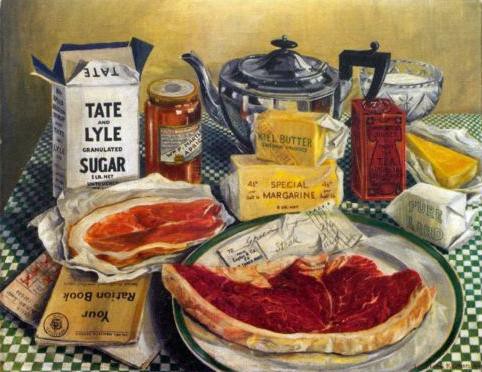
This painting by Leonora Green shows a week’s rations for a family in 1941.
Along with the strict reduction in meats, fats and sugars, the intake of whole foods (as opposed to processed food) marks a significant differences between a wartime rations plan like Carolyn’s and the usual modern diet plans: “I’ve attended many well recognized diet clubs over the years in my hope of curing my food addiction,” she told me. “And do you know what I found? Most were promoting their own convenience food products or recommending processed convenience foods … food that had been tampered with, that had added chemicals that are hard to pronounce. (Trust me, that isn’t a good sign.)”
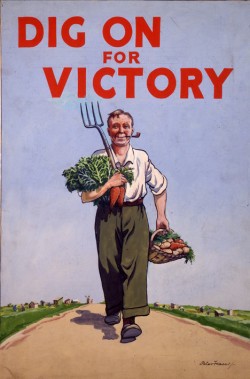
Carolyn was quick to point out that the plan she follows mimics the eating of those fortunate enough to have gardens in the British countryside or good access to one of the urban gardens that sprang up at the time: “People were encouraged to ‘dig for victory’ and flower beds and gardens became vegetable gardens or small urban farms as people grew lots of fresh vegetables, kept chickens and rabbits to supplement their rations,” she said. “I am in a way eating how I would have done during the war with a large productive back garden as a very large portion of my diet is plant-based, especially at the moment as I have turned vegan for 60 days to experience how vegans coped.”
For a 2007 Daily Mail article, a family with four kids lived on rations for a week. The piece noted that, while cooking with vegetable fats, like olive oil, is more healthy than the animal fats (i.e., lard) used during rationing, the diet was otherwise well balanced.
But even with good access to a variety of fruits and vegetables, surviving on rations was extremely difficult. And Carolyn admits that following this wartime diet in a modern environment can be challenging, too: “It can be incredibly difficult in those early weeks as your body adjusts, and getting used to cooking from scratch with limited supplies is challenging.” Dee Brooker, the mother featured in the Daily Mail article, also found the preparation of the food a challenge: “Meals normally take me about 30 minutes and while I really enjoyed cooking from scratch and the fact that I could see exactly how much salt, sugar and fat we were eating, it all took so long. One day I spent five hours chopping and preparing food and I was tied to that cooker for two to three hours most days.”
For Carolyn, one benefit of her 1940s experiment is it helps to keep the boredom that comes with ordinary dieting at bay: “I have approached this as a dietary social experiment. Were home front recipes during WWII absolutely ghastly? What did they really taste like? I found the names of recipes like Mock Goose & Lord Woolton Pie fascinating and needed to find out for myself what our grandparents and parents really ate. So losing weight by attempting to live 100% on a wartime diet was also a lesson in living history for me.”
Of the wartime recipes Carolyn has made to date, she says the cottage pie has been one of the best; the recipe, which made enough to feed her entire family, uses what would have been a week’s rations of minced beef for two people. She also recommends the sweet bread and apple pudding, which would’ve used up the rations for two ounces of butter or margarine, two ounces of sugar and one egg. Not-so-successful recipes have included one for curried carrots (“even Spam is better”) and one for mock cream that had a “gritty texture” and, disappointingly, “tasted nothing like cream.”
Related: The Vicious Trademark Battle Over ‘Keep Calm And Carry On’ and “Are You Airminded?” The Slang Of War.
Stephany Aulenback lives in Nova Scotia with her husband and two children. She blogs at Crooked House.
